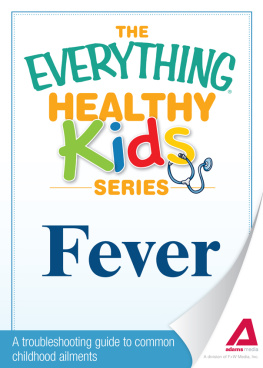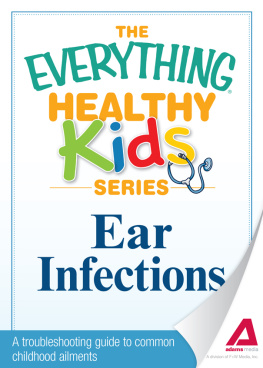The Everything Healthy Kids Series
Digestive Problems
A troubleshooting guide to common childhood ailments
Adams Media, a division of F+W Media, Inc.
Avon, Massachusetts
Contents
Introduction
For more than 10 years, millions of readers have trusted the bestselling Everything series for expert advice and important information on parenting and health topics ranging from pregnancy and postpartum care to asthma, dyslexia, and juvenile diabetes. Packed with the most recent, up-to-date data, Everything guides help you get the right diagnosis, choose the best doctor, and find the treatment options that work for your child.
The Everything Healthy Kids Series books are concise guides, focusing on only the essential information you need. Whether youre looking for information on how to treat ailments in children from infants to teenagers, advice on raising happy, well-adjusted kids, or suggestions for how to get your child to eat the right foods, theres an Everything Healthy Kids Book for you.
Childhood Illnesses
Few occasions provoke more anxiety in parents than when a child is ill, and it is the duty of the pediatrician to calm those parental fears in times of distress. The goal of the Everything Healthy Kids Series is not to discredit the ancient wisdom of parenthood. The innate instinct of parents often proves uncanny. Indeed, much of the knowledge that has been passed down through the generations has proved to be both practical and life saving. Everything Healthy Kids books are designed to supplement experience and instinct to empower parents with the latest, most accurate medical information. This allows you to make the best decision for your children when they are not feeling well.
While instinct and experience are often valuable, there are also numerous myths associated with childrens health. Though the origin of most of these misconceptions is obscure and lacking in supporting evidence, they tend to be tenaciously held by many parents. These guides will shed light on these areas of misunderstandings.
This book is not intended to serve as a comprehensive reference book concerning the care of your child. Rather, it is meant to complement medical source books such as those. A typical parent with children is likely to be too tired to read another comprehensive manual on how to raise children. Most parents are lucky to garner enough energy to make it through the day without collapsing. This is a book that you can read while your children are taking their afternoon naps. Not only does it provide an interesting read, it also educates you in a quick and easy format on how to better care for your loved ones.
Because this book is not written for medical professionals, no prior medical knowledge is required to read and understand the content. In fact, one of the aims of this book is to translate inaccessible information and make it available to every parent.
Lastly, this book was purposely designed to have a light tone and to be easy to read. Dealing with a sick child is stressful enough without having to wade through extensive medical jargon for a clear answer. This is definitely not a cut-and-dried medical textbook. At all times, the information is relevant to the reader and readily applicable to real-life situations.
Vomiting and diarrhea are the banes of the pediatricians existence. Perhaps due to the prevalence of stomach problems, there is a wealth of old wives tales and remedies about vomiting and diarrhea. Surprisingly, most of the alleged age-old wisdom is not helpful in these situations, and it can even be harmful. Before you venture out and follow your great-aunts advice for curing your childs diarrhea, this guide will help make sure you have the facts straight.
If youd like to learn more about childhood illnesses, check out The Everything Parents Guide to Childhood Illnesses , available in print (978-1-59869-239-6) and eBook (978-1-60550-275-5) formats.
Baby Spit-Ups
Acid reflux disease plagues many adults. While reflux can also occur in babies, baby reflux is not the same as adult reflux. For one thing, unlike the adult form of the condition, reflux in babies does not increase the risk of ulcer or cancer. In addition, reflux is far more common in otherwise healthy babies than it is in adults. Most importantly, infantile reflux is mostly a benign condition, and affected babies almost always grow out of their reflux condition in a matter of months.
Anatomy Lesson
To understand reflux and other intestinal conditions, it is necessary that you first become acquainted with some basic anatomy. Lets follow the path of the food your baby eats after he swallows it.
The esophagus is a long and narrow tube made of muscle that connects the mouth to the stomach. Before the food makes it to the esophagus, it must stay clear of the windpipe first. Any food that goes into the wrong tube could have disastrous consequences. For this reason, all babies are equipped right at birth with a sophisticated muscle-control system that prevents this from happening.
Every time your baby swallows, an automatic trap door covers up the entrance to the windpipe to prevent food from going down the wrong pipe. This system of control is so essential that it is intact even in many brain-damaged babies. It is absent only in the most severely neurologically impaired children.
Essential
If your baby has reflux, your pediatrician may want to measure the babys weight frequently to ensure that he is thriving. Your babys weight gain is the most important indicator that everything is going well and that no medical intervention is necessary for his reflux.
When the food reaches the stomach, a muscular gateway briefly opens up to allow the food to enter the stomach. This valve technically only allows food to go from the esophagus into the stomach. As youll learn later, this valve doesnt always work perfectly.
Once the food is inside the stomach, it gets churned around for a while, and some of the water in the food passes through the stomach lining and into the body. Once the churning is complete, another one-way gateway opens up, and the food is transported into the intestine. Like a hyped-up bouncer, this second valve sometimes becomes overzealous. Problems occur when it is hyperactive and doesnt allow food to pass through its door.
Reflux Management
Food is only supposed to move in one direction, from the esophagus to the stomach. Once the food is inside the stomach, it should not go back up into the esophagus or the mouth. In babies with reflux, however, this is not the case.
The stomach valve in these babies is not sealed very tightly. So as the stomach churns the food, the content sometimes spills out. Imagine a malfunctioning zip-top bag full of last nights clam chowder. If the bag isnt tightly sealed, and you start jiggling the bag violently, youre going to end up with a big mess in the kitchen.
Fortunately, as the baby grows older, the function of the valve steadily improves. By the time the baby is nine months to a year old, most babies with reflux should stop spitting up. Until the condition resolves, the most important thing is that these babies retain enough calories to gain weight. As long as your baby can take in enough calories to grow, it doesnt matter how much milk hes spitting up. It is messy and inconvenient, but spitting up in a thriving baby is entirely harmless.




















